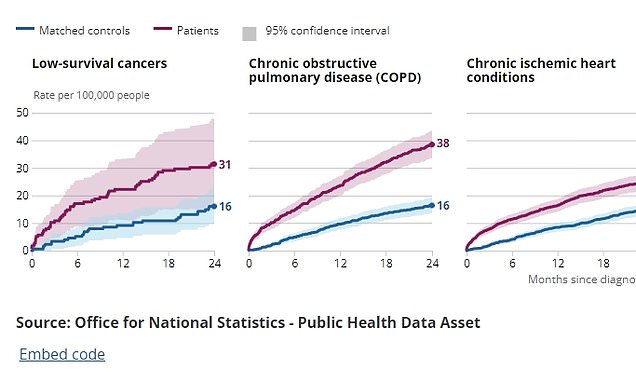Suicide rates twice as high among patients with terminal cancers, heart disease and COPD, official data shows
- Patients with one of big three killers up to 2.4x more likely to commit suicide
- Risk spikes sharply after the devastating blow of diagnosis but slows over time
- For confidential support, call the Samaritans on 116123 or visit samaritans.org
Terminally-ill Britons are twice as likely to commit suicide as healthy people, official data shows.
A first of its kind analysis by the Office for National Statistics found the risk spikes sharply after the devastating blow of a diagnosis but slows over time.
People battling a low-survival cancer or heart and lung diseases are up to 2.4 times more likely to take their life in the year after being diagnosed, the report said.
Between 2017 and 2020, there were around 22 suicides per 100,000 terminal cancer patients compared to nine per 100,000 in a control group of healthy people.
The rate was similar among people suffering chronic obstructive pulmonary disease (COPD), a group of lung conditions that cause breathing difficulties.
Around 16 suicides per 100,000 patients with coronary heart disease were recorded in the year after a diagnosis, compared to 8.5 in people of a similar age, education and level of income who did not have the conditions.
More than 1.7m people were diagnosed with one of the big three killers in England during the analysis, commissioned in April last year by then-Health Secretary Matt Hancock.
The findings have reignited the debate around assisted dying.

Between 2017 and 2020, there were around 22 suicides per 100,000 terminal cancer patients compared to nine per 100,000 in a control group of healthy people. The rate was similar among those with chronic obstructive pulmonary disease (COPD), a group of lung conditions that cause breathing difficulties. Around 16 suicides per 100,000 patients with coronary heart disease were recorded in the year after a diagnosis compared to 8.5 in people of a similar age, education and level of income who did not have the conditions

The first of its kind analysis by the Office for National Statistics found the risk spikes sharply after the devastating blow of a diagnosis but slows over time
The ONS linked death certificates to the 2011 Census and NHS records between January 1, 2017, and March 31, 2020.
In that time there were 17,195 people who died due to suicide, of which 2.6 per cent also had COPD, 2.7 per cent had heart disease and 0.3 per cent had a deadly cancer, including pancreatic, lung, throat and liver cancers.
Gambling and social media use will be considered as potential risk factors in a new suicide prevention plan being drawn up by ministers.
The first update to the plan in 10 years will also look at harms done to people’s mental health during the pandemic.
Experts advising the Government said focusing on issues such as online safety, gambling and Covid reflected the ‘changing pattern of risk’ for suicide.
It is part of a consultation to inform the National Suicide Prevention Plan and the broader 10-year mental health plan.
Problem gambling and social media use are feared to have taken a terrible toll on the nation’s mental health.
The exact number of suicides linked to the behaviours is not clear but officials estimate problem gambling costs NHS England nearly £1bn annually due to mental and physical harms.
Nearly 30,000 people in England have become alcoholics due to gambling, according to the UK Health Security Agency.
Concern has also been expressed that social media could be contributing to higher rates of self-harm and suicide among children.
The consultation comes amid a cost of living crisis and fears that the losses to life and income during the pandemic will fuel a wave of depression.
The health conditions were chosen because in most cases the diseases are progressive and cannot be reversed by treatment, the ONS said.
‘In many instances, people diagnosed with these conditions would meet the definition of having a terminal illness,’ the report added.
The rates among patients with the three conditions were compared to healthy people from similar backgrounds, known as a matched control group.
Results showed that one year after diagnosis for low-survival cancers, the suicide rate was 22.2 per 100,000 people.
That was 2.4 times higher than the suicide rate for matched controls, 9.1 deaths per 100,000 people.
There were 23.6 suicides per 100,000 COPD patients 12 months after a diagnosis, compared to 9.7 in the healthy group, another 2.4-fold difference.
The suicide rate for patients with heart disease was 16.4, nearly two times higher than for the control group, 8.5.
Marjorie Wallace, chief executive of the mental health charity SANE, said it was ‘unforgiveable and inhumane’ that people who are dying should have to resort to ending their lives ‘alone and abandoned’.
‘For those who are nearing the end of life and wish to ease the dying process, their motivation is to shorten death, not shorten life, and therefore traditional suicide prevention measures are not an appropriate response,’ she added.
Care Not Killing, a UK alliance which opposes a law change, said the figures do not demonstrate the need for a change in the law on assisted dying.
The group’s chief executive Dr Gordon Macdonald said the numbers instead suggest that ‘much more work needs to be done to support dying and vulnerable people by providing them with universal access to treatment for both their physical and psychological needs’.
He added: ‘This means extending high quality palliative care to all those who need it, not reaching for a cheap short-term solution of facilitating a rise in people committing suicide or having their lives ended by the state.’
For confidential support, call the Samaritans on 116123 or visit samaritans.org
Source: Read Full Article
